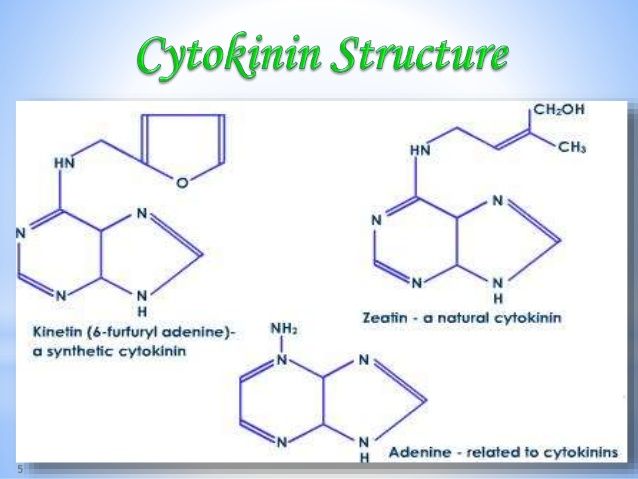Published July 3, 2020 | By Mike Petersen
Image Above:
The basic molecule rings of a cytokinin. Organic Chemistry comes to light.
Agronomic sciences have advanced a long ways in the last 5 years which pleases me. Nigh on 40 years ago this fall I worked in a backhoe pit along side a good friend and Technician for one of the Soil Conservation District field offices (now USDA-NRCS) in eastern Colorado to study and determine why an irrigated corn crop was doing so poorly – we were looking at roots and if compaction was the ugly culprit. For sure it is not like yesterday but I remember working with this man on several hundred soil-root pits until his retirement and later passing on. Kudos to you Marv for getting me into this dimension of the soil science profession. Why do I mention this? A highly regarded scientist from back in the eastern Corn Belt wrote recently about the importance of cytokinins, roots, root tips and the value of these phytohormones.
John Kempf, writes a daily blog that detailed a few words I would like you to read, “Cytokinins are produced in growing root tips and cobalt is a key enzyme cofactor needed for cytokinin synthesis. The key is that a growing root tip is needed to produce cytokinins, particularly at the stages of bud initation and pollination.
A healthy disease resistant plant will always be cytokinin dominant, rather than auxin dominant. This means they will always have more growing root tips (producing cytokinins) than they have growing shoot tips or seeds (producing auxins). It also means that these plants will have larger root biomass than vegetative biomass. Cytokinins are produced in growing root tips and cobalt is a key enzyme cofactor needed for cytokinin synthesis. The key is that a growing root tip is needed to produce cytokinins, particularly at the stages of bud initation and pollination. A healthy disease resistant plant will always be cytokinin dominant, rather than auxin dominant. This means they will always have more growing root tips (producing cytokinins) than they have growing shoot tips or seeds (producing auxins). It also means that these plants will have larger root biomass than vegetative biomass.” He goes on to speak about plants such as edible beans and soybeans are quite dependent upon cytokinins to produce many pods and healthy beans.
Allow me to expand for a moment, having healthy roots, thousands of square inches of soil infiltrated by roots, root hairs and root tips will produce a lot of this phytohormone to stimulate photosynthesis and sugar production, move nutrients up the xylem tissues to the leaves and keep the cycle of plant life going all season until senescence in nearly all if not all crops farmers grow. To tell you what I have measured in root pits and explored with others the under-the-surface hidden world of roots would be a long conversation – I am saying that Dr. Kempf just tapped the upper part of the iceberg with this and I hope he writes more on the subject.
In my 1700+ root pits since that first one with Marv back in 1981 exposed for a farmer I have measured root lengths, root density, root penetration, counted linear inches of even the smallest roots, photographed roots, invested 8-9 hours in a soil pit to get the facts. I have read numbers and numbers of scientific journal articles about roots, own texts about roots and so on and so on. Well that is nice you are weird Mike. No, it is this part of soil science that resonates with me for me to really know why the plant does what it does in a growing season, it is why I find some corn varieties excel where others flop-fizzle, why knowing that compaction is the number 1 limitation for top root development, cytokinin expression and best yield outcomes. When we get down to it, knowing how plants move nutrients, absorb and move water, utilize phytohormones that sense details of the soil environment to aid crop development – Wow!
We at Orthman Manufacturing have a good understanding of compaction and soil resistance and what kinds of tools farmers need to combat this problem that plagues growers not only in conventional tillage systems, yes you folks with No-Till are not immune to it and even growers who routinely strip till are aware of the compaction culprit. We study it, we talk about it and then provide solutions at Orthman. As we do we are learning more about what goes on in the root system down to the xylem tissues so we can be an informed resource to growers all over the globe. Folks it is not just selling iron, we are offering tools that are steel but also tools that go into your mental toolbox to give you more in the harvest truck that goes to market. Get in touch with us today.
